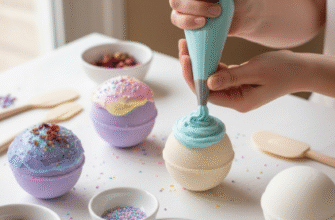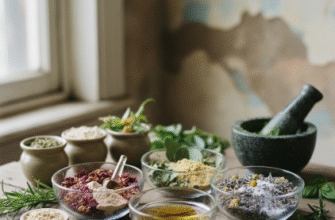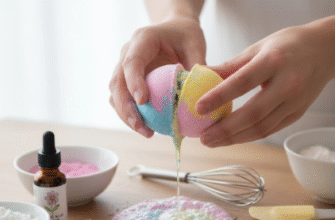Tired of scanning ingredient lists packed with unpronounceable chemicals? Do you dream of slathering on a body cream that feels utterly luxurious but doesn’t break the bank? Well, get ready to transform a simple pantry staple into your skin’s new best friend. Making your own whipped coconut oil body cream is surprisingly easy, wonderfully satisfying, and leaves your skin feeling incredibly soft and moisturized. It’s a little bit of DIY magic that brings spa-like indulgence right into your home, using ingredients you can trust.
Forget complicated processes and expensive equipment. If you have coconut oil and an electric mixer, you’re basically halfway there. This simple recipe focuses on the star ingredient, letting its natural goodness shine through. Let’s dive into creating this jar of fluffy, cloud-like goodness.
Why Bother Making Your Own?
In a world overflowing with commercial skincare products, why take the time to whip up your own? The reasons are compelling!
Know Your Ingredients: This is a big one. When you make it yourself, you have complete control. No hidden parabens, phthalates, synthetic fragrances, or harsh preservatives. Just pure, simple ingredients that you choose. If you have sensitive skin, this is a game-changer, allowing you to avoid potential irritants.
Cost-Effective Luxury: High-quality natural body butters can be pricey. A jar of organic coconut oil, however, goes a long way and costs significantly less than many boutique creams. You get a premium-feeling product for a fraction of the price.
Surprisingly Simple: Despite the luxurious end result, the process is incredibly straightforward. It mainly involves whipping! It’s a fun, quick project with immediately rewarding results.
Customizable Creations: While this basic recipe is fantastic on its own, it’s also a perfect base for customization. You can add your favorite essential oils for a personalized scent or include other skin-loving oils for added benefits. More on that later!
Reduced Waste: By refilling your own jars, you cut down on plastic packaging waste associated with store-bought lotions.
Gathering Your Simple Supplies
You really don’t need much to create this whipped delight. Here’s your basic toolkit:
Ingredients:
- Coconut Oil: Around 1 cup (solid state). The star of the show! Using unrefined (virgin) coconut oil will give you a subtle coconut scent and retain more of its natural compounds. Refined coconut oil works perfectly fine too, especially if you prefer no coconut smell – it’s odourless and flavourless. Ensure it’s solid, not melted, before you start.
- Optional: Essential Oils: 10-20 drops of your favourite skin-safe essential oil for fragrance (e.g., lavender, sweet orange, geranium, frankincense). Always choose high-quality oils.
- Optional: Vitamin E Oil: A few drops (about 1/2 teaspoon per cup of coconut oil) can act as a mild antioxidant and adds extra skin nourishment.
- Optional: Other Liquid Carrier Oils: 1-2 tablespoons of a liquid oil like jojoba, sweet almond, or grapeseed oil can make the final cream feel slightly less greasy and add different properties.
Tools:
- Electric Mixer: A stand mixer with a whisk attachment is ideal, but a hand mixer works just as well (it just requires a bit more patience and arm power!).
- Mixing Bowl: Choose a bowl large enough to accommodate the oil as it whips up and increases in volume. A chilled bowl can sometimes help the whipping process, especially in warmer environments.
- Spatula: For scraping down the sides of the bowl.
- Measuring Cups and Spoons: For accuracy.
- Storage Container: An airtight glass jar with a wide mouth is perfect for easy scooping. Make sure it’s clean and completely dry.
The Heart of the Cream: Coconut Oil
Coconut oil is uniquely suited for whipping into a body cream. Its magic lies in its melting point. It’s solid at typical room temperature (below about 76°F or 24°C) but melts upon contact with skin, allowing for lovely absorption. When you whip solid coconut oil, you incorporate air into it, transforming its dense texture into something light, airy, and incredibly spreadable – much like whipping cream or making frosting.
While many tout coconut oil for various skin benefits, from moisturizing dry patches to soothing irritation, it’s important to remember that individual results vary. For this DIY project, we’re focusing on its fantastic ability to moisturize and create that wonderful whipped texture. If you have very acne-prone skin, particularly on your face, you might want to patch test first, as coconut oil can be comedogenic (pore-clogging) for some individuals. However, for body application, most people find it wonderfully hydrating.
Let’s Get Whipping: Step-by-Step Guide
Ready to create some magic? Here’s how to turn solid oil into a fluffy cloud:
Step 1: Measure Your Oil: Scoop your solid coconut oil into your mixing bowl. If your oil is slightly melted due to warm temperatures, pop it in the refrigerator for 15-30 minutes until it’s firm but not rock solid. You should be able to indent it easily with a spoon.
Step 2: Start Whipping: Using your electric mixer (stand or hand), start whipping the coconut oil on a low speed. Gradually increase the speed to medium-high. It will look crumbly at first, but keep going!
Step 3: Keep Going!: This is where the transformation happens. Continue whipping for approximately 5 to 10 minutes. The exact time depends on your mixer’s power and the oil’s temperature. You’ll see the oil change texture, becoming lighter in colour and much fluffier in consistency. Scrape down the sides of the bowl occasionally with your spatula to ensure everything gets incorporated evenly.
Step 4: Achieve Peak Fluffiness: You’re looking for a light, airy texture with soft peaks, similar to whipped cream or buttercream frosting. It should have noticeably increased in volume.
Step 5 (Optional): Add Extras: If you’re adding essential oils, Vitamin E oil, or other liquid carrier oils, now is the time. Reduce the mixer speed to low and slowly drizzle in your chosen additions. Whip for another 30 seconds to a minute, just until everything is combined. Don’t overmix at this stage.
Verified Tip: For the best whipped texture, ensure your coconut oil is solid but pliable before starting. If it’s too hard, whipping will be difficult. If it’s melted, it simply won’t whip into a fluffy consistency. Aim for the texture of slightly softened butter.
Step 6: Transfer to Container: Carefully spoon your beautiful, whipped coconut oil cream into your clean, dry storage container. Seal it tightly.
Personalizing Your Whipped Creation
The basic recipe is lovely, but here’s how you can tailor it:
Scent Sensations:
Essential oils offer a world of aromatic possibilities. Consider:
- Calming: Lavender, Chamomile, Frankincense
- Uplifting: Sweet Orange, Lemon, Grapefruit (use phototoxic citrus oils with caution if exposing skin to sun), Peppermint (use sparingly, very cooling)
- Balancing: Geranium, Clary Sage
- Grounding: Cedarwood, Patchouli
Important: Always use high-quality, pure essential oils. Do a patch test on a small area of skin before incorporating a new essential oil into your batch, especially if you have sensitive skin. Remember, a little goes a long way!
Texture Tweaks:
While pure whipped coconut oil is great, you can modify the feel slightly:
- Add Richness: Melt 1-2 tablespoons of shea butter or cocoa butter. Let it cool until it’s slightly solidified but still soft (not liquid, not rock hard). Add it to the coconut oil *before* you start the main whipping process. This adds extra thickness and different moisturizing properties.
- Reduce Greasiness: Adding 1-2 tablespoons of a lighter liquid oil like jojoba (which closely mimics skin’s natural sebum), grapeseed, or sweet almond oil during the final whipping stage can make the cream feel slightly less heavy or oily on the skin for some users.
Storing Your Homemade Treasure
Proper storage is key to maintaining that lovely whipped texture.
Keep it Cool: Store your whipped coconut oil cream in an airtight container in a cool, dark place. Your bathroom cabinet or bedside table is usually fine, provided it doesn’t get too warm.
Temperature Matters: Remember coconut oil’s melting point (around 76°F / 24°C). If your home gets warmer than this, the cream will soften and potentially melt back into liquid oil. It will lose its whipped texture.
Important Information: This whipped cream is sensitive to heat! If it melts, it will lose its fluffy texture but is still perfectly usable as a moisturizing oil. You can try re-solidifying it in the fridge and then re-whipping it, though the texture might be slightly different. Always use clean, dry hands or a scoop to take cream from the jar to avoid introducing water, which can shorten its shelf life.
Shelf Life: Because this recipe doesn’t contain water or strong preservatives (unless you add Vitamin E, which helps slightly), its shelf life is generally shorter than commercial products. Use it within 3-6 months for best quality. If it ever smells off or changes colour drastically, discard it.
How to Use Your Fluffy Body Cream
Using your homemade cream is pure bliss. A little goes a long way!
Scoop out a small amount with clean fingers or a cosmetic spatula. Warm it slightly between your hands – it will melt readily with your body heat. Massage gently into your skin. It’s particularly wonderful applied to slightly damp skin after a shower or bath to lock in moisture. Focus on areas prone to dryness, like elbows, knees, and heels. Enjoy the simple luxury and the soft, hydrated feel of your skin!
Troubleshooting Tips
Even simple recipes can sometimes hit a snag. Here are common issues:
It Won’t Whip: Your coconut oil was likely too warm or completely melted. Chill it in the fridge until solid but pliable, then try again.
It’s Too Hard: This can happen if stored in a very cold place. Let it sit at room temperature for a little while to soften slightly before use. Adding a tablespoon or two of liquid carrier oil during whipping can also help keep it softer in cooler temps.
It Melted!: As mentioned, warm temperatures are the enemy of whipped coconut oil. You can still use the melted oil, or chill it and re-whip it. Consider making smaller batches during very hot weather.
It Feels Grainy: This can sometimes happen if the oil cools too slowly or unevenly after being slightly melted. Re-whipping can sometimes help smooth it out.
Embrace Simple, Homemade Luxury
Making your own whipped coconut oil body cream is more than just a DIY project; it’s an act of self-care. It connects you to the ingredients you put on your skin, offers a moment of creative satisfaction, and results in a genuinely luxurious product without the hefty price tag or questionable additives. It’s proof that sometimes, the simplest things – like pure coconut oil whipped into a cloud – are the most wonderful. So go ahead, grab that mixer, and treat your skin to some homemade happiness!








